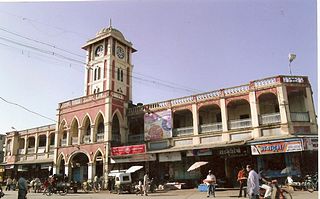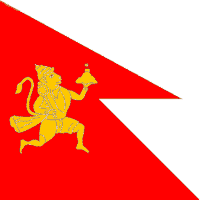
Miraj is a city that is part of the Sangli-Miraj-Kumand metropolitan region in Sangli district, Maharashtra. Founded in the early 10th century, Miraj was an important jagir of the Bijapur Sultanate.

Narayanrao was the 10th Peshwa of the Maratha Confederacy from November 1772 until his assassination in August 1773. He married Gangabai Sathe who later gave birth to Sawai Madhavrao.

The Deccan States Agency, also known as the Deccan States Agency and Kolhapur Residency, was a political agency of India, managing the relations of the Government of India with a collection of princely states and jagirs in western India.
Kurundwad is a town on the banks of the Panchganga river, 55 km from Kolhapur in the Indian state of Maharashtra.

Miraj Senior was one of two Maratha princely states during the British Raj: 'Miraj Junior' and Miraj Senior. The two states separated in 1820. It was under the southern division of the Bombay Presidency, forming part of the southern Mahratta Jagirs, and later the Deccan States Agency.

Miraj Junior was one of two Maratha princely states during the British Raj: 'Miraj Senior' and Miraj Junior. The two states separated in 1820. It was under the southern division of the Bombay Presidency, forming part of the southern Mahratta Jagirs, and later the Deccan States Agency.

Jamakhandi is a city in Bagalkot district in the Indian state of Karnataka. It was the capital of the former princely state of Jamkhandi. It is located 90 km towards west from district headquarters. It is the first princely state to merge in constituent India based on demand to make Jamkhandi as a district. It is a subdivision of the district. Mudhol, Bilagi, Rabakavi-Banahatti, Teradal and Jamakhandi taluks come under Jamakhandi subdivision.

Kolhapur State or Kolhapur Kingdom (1710–1949) was a Maratha princely State of India, under the Deccan Division of the Bombay Presidency, and later the Deccan States Agency. It was considered the most important of the Maratha principalities with the others being Baroda State, Gwalior State and Indore State. Its rulers, of the Bhonsle dynasty, were entitled to a 19-gun salute – thus Kolhapur was also known as a 19-gun state. The state flag was a swallow-tailed saffron pennant.

Akkalkot State during the British Raj, was a Maratha princely state ruled by the Bhonsle dynasty. The non-salute state came under the Deccan States Agency and was bordered by Hyderabad State and the Bombay Presidency.

Jath State, was one of the non-salute Maratha princely states of Deccan States Agency, one of the former Southern Maratha Jagirs. Jath State and Daphlapur State were the only two states belonging to the Bijapur Agency under the Bombay Presidency, which later became part of the Deccan States Agency.

Mudhol State was a princely state during the British Raj. The rulers were from the Ghorpade Dynasty of the Marathas. It was one of the former states of the Southern Maratha Country and its capital was the city of Mudhol in present-day Bagalkote District of Karnataka State in India. The last ruler was HH Shrimant Raja Bhairavsinhrao Malojirao Ghorpade II. Mudhol acceded to the Dominion of India on 8 March 1948, and is currently a part of Karnataka state.

Sangli State was one of the 11-gun salute Maratha princely states of British India. It was under the Kolhapur-Deccan Residency in the Bombay Presidency, and later the Deccan States Agency.

Dewas Junior was established by Jivaji Rao I Puar in 1728 during the Maratha conquest of Central India. It was a 15-gun salute Maratha princely state. On 12 December 1818, it became a British protectorate.

Dewas Senior was established by Tukoji Rao I Pawar during the Maratha conquest of Central India. It was a 15 Gun Salute Maratha princely state. On 12 December 1818 it became a British protectorate.

Kurundvad Senior, also spelt as 'Kurundwad', was one of two Maratha princely states during the British Raj: 'Kurundvad Junior' and Kurundvad Senior. The two states separated in 1854 and less than a century later, on 8 March 1948, both states acceded to the Indian Union.
Madhavrao Khanderao Bagal, also called Bhai Madhavrao Bagal, was a noted writer, artist, journalist, social reformer, political activist, orator and freedom fighter from Kolhapur.
The Bhat Peshwa family earlier known as Bhat family is a prominent Indian Chitpavan Brahmin family who dominated India for around 100 years in the late 18th century and early 19th century. Most of the members in this family were the Peshwas in the Peshwa Era of the Maratha Empire, and Peshwa later became their family name. During their regime, most of the Indian subcontinent was under their control. The last Peshwa, Baji Rao II, was defeated by the British East India Company in the Third Anglo-Maratha War in 1818. The territory was annexed to the British East India Company's Bombay Presidency, and he was pensioned.
Raja Madhavrao Hariharrao Patwardhan KCIE was the 5th Raja of the princely state of Miraj Jr. of British Raj during the reign (1899–1950). He signed the accession to the Indian Union on 8 March 1948 which ended the separate existence of Miraj Junior state.
The Patwardhan princely state was established by the Patwardhan family, ruling several parts of the Maratha Empire from 1733 till 1948, when it acceded to the Dominion of India. At its peak, various branches of the dynasty controlled several Jagirs within the Maratha Empire, and later became protectorate Princely states in British India.













